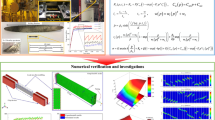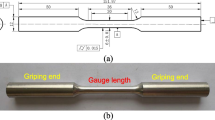Abstract
We propose an approach to determination of allowable stresses by a static-strength criterion for materials of structures that operate at very low temperatures (T≤20 K). This approach takes into account the qualitative change in the nature of deformation of the material, which has a significant effect on the mechanical characteristics and the specific work of deformation. The choice of critical stresses for these conditions is substantiated. The calculations are performed by introducing corrections for low-temperature hardening of the material in the presence of the intermittent-flow effect. We discuss the possibility of taking into account the influence of strong magnetic fields on the magnitude of allowable stresses.
Similar content being viewed by others
References
N. V. Novikov, A. L. Maistrenko, and A. N. Ul'yanenko,Structural Strength at Low Temperatures [in Russian], Naukova Dumka, Kiev (1979).
V. A. Strizhalo, N. V. Filin, B. A. Kuranov, et al.,Strength of Materials and Structures at Cryogenic Temperatures [in Russian], Naukova Dumka, Kiev (1988).
G. S. Pisarenko and V. A. Strizhalo, “The influence of very low temperatures on the deformation behavior of structural alloys and on the choice of allowable stresses,” in:Strength of Materials and Structures at Low Temperatures [in Russian], Naukova Dumka, Kiev (1984), pp. 3–12
RTM 56-60. Vessels and Apparatuses. Methods of Design Calculation of Elements and Assembly Units of Metals That Are Ductile under Operating Conditions [in Russian], Adopted on October 1, 1969.
OST 26-04-2585-86. Cryogenic and Cryogenic-Vacuum Engineering. Vessels and Chambers. Standards and Methods of Calculation of the Strength Stiffness, and Service Life of Welded Structures [in Russian], Adopted July 1, 1986.
B. A. Kuranov, A. A. Lebedev, N. V. Novikov, and V. A. Strizhalo, “On creating a standard on calculations of the strength stiffness, and service life of thin-walled shell structures in cryogenic engineering,”Probl. Prochn., No. 1, 98–101 (1983).
DSTU 2464-94. Strength Calculation and Testing. Methods of Determination of Equivalent and Allowable Stresses under Static Loading [in Ukrainian], Valid as of January 1, 1995.
É. V. Chechin, “Savings in ductile materials due to a changeover from a force-based method of determination of allowable stresses to an energy-based one,”Probl. Prochn., No. 3, 52–62 (19996).
Z. S. Basinski, “The instability of plastic flow of metals at very low temperatures”,Proc. Roy. Soc.,A-240, 229–242 (1957).
D. A. Wigley,Mechanical Properties of Materials at Low Temperatures, Plenum Press, New York, London (1971).
V. I. Startsev, V. Ya. Il'ichev and V. V. Pustovalov,Plasticity and Strength of Metals at Low Temperatures [in Russian], Metallurigya, Moscow (1975).
V. A. Strizhalo and E. V. Vorob'ev, “Low-temperature intermittent flow of structural alloys,”Probl. Prochn., No. 8, 37–46 (1993).
V. A. Strizhalo and E. V. Vorob'ev, “Low-temperature intermittent flow of hardenable materials,”Probl. Prochm., No. 10, 3–8 (1994).
V. A. Strizhalo, E. V. Vorob'ev, and L. S. Novogrudskii, “The influence of prestrain on the intermittent flow of materials at a temperature of 4.2 K,”Probl. Prochn., No. 8, 12–20 (1995).
E. V. Vorob'ev and V. A. Strizhalo, “Development of low-temperature stepwise deformation of metals and ways of preventing it,”Probl. Prochn., No. 1, 41–52 (1999).
G. A. Malygin, “Heating up of slip lines and bands in fine crystals at low temperatures,”Fiz. Metal. Metalloved.,20, Issue 9, 2825–2827 (1978).
G. A. Malygin, “Thermal mechanism of the instability of deformation of metals at low temperatures,”Fiz. Metal. Metalloved.,65, Issue 5, 864–874 (1987).
V. Ya. Il'ichev, I. N. Nechiporenko, and I. A. Shapovalov, “The influence of the strain rate on the mechanical and plastic properties of some stainless steels at low temperatures,”Ukr. Fiz. Zhurn.,29, Issue 6, 907–915 (1984).
V. A. Strizhalo, V. Yu. Bugaev, and I. I. Medved' “The influence of the strain rate on the behavior of structural alloys under static tensile loading at very low temperatures,”Probl. Prochn., No. 1, 3–8 (1990).
V. G. Smirnov and Yu. P. Solntsev, “The influence of the strain rate on the heating-up of specimens of titanium alloy in static tests at temperatures of 293 to 4.2 K,”Probl. Prochn. No. 12, 70–78 (1992).
V. A. Strizhalo V. Yu. Bugaev, and I. I. Medved' “The influence of the scale factor on the special features of deformation of structural alloys in static tension at very low temperatures (4.2 K),”Probl. Prochn. No. 5, 61–66 (1990).
V. A. Strizhalo, L. S. Novogrudskii, and E. V. Vorob'ev, “On the development of the interstate standard ‘Metals. Method of Tensile Testing at Temperatures of 293 to 4.2 K’” in:Urgent Problems of Mechanics, Strength, and Thermal Conductivity at Low Temperatures (IV Scientific and Technical Seminar). Abstracts of Papers [in Russian], International Academy of Cold, St. Petersburg (1998), pp. 10–11.
E. V. Vorob'ev, “On the relationship between the intermittent flow and the mechanical characteristics of cryogenic-engineering alloys,” in:Strength of Materials and Structures at Low Temperatures (III All-Union Conference). Abstracts of Papers [in Russian], Kiev (1991), pp. 11–12.
T. Blewitt, R. Coltman, and J. Redman, “Dislocations and mechanical properties of crystals,” in:Held at Lake Placid (Intern. Conf.) Papers (1956), pp. 125–146.
S. N. Komnik and V. V. Demirskii, “Relationship between the plastic flow and the mechanical instability of materials at cryogenic temperatures,” in:Cryogenic Materials and Welding Them (Intern. Conf.), Papers [in Russian], Naukova Dumka, Kiev (1986), pp. 61–66.
E. V. Vorob'ev, “Low-temperature hardening of structural alloys under the action of strong magnetic fields”,Probl. Prochn., No. 6, 48–52 (1990).
N. A. MakhutovDeformation Criteria for Fracture and Strength Calculation for Structural Elements [in Russian], Mashinostroenie, Moscow (1987).
A. A. Lebedev and É. V. Chechin “On the choice of allowable stresses in design calculation by the static-strength criterion,”Probl. Prochn., No. 4, 32–34 (1980).
G. S. Pisarenko and A. A. Lebedev,Deformation and Strength of Materials in a Complex Stress State [in Russian], Naukova Dumka, Kiev (1976).
Additional information
Institute of Problems of Strength, National Academy of Sciences of Ukraine, Kiev, Ukraine. Translated from Problemy Prochnosti, No. 5, pp. 42–52, September–October, 1999.
Rights and permissions
About this article
Cite this article
Vorob'ev, E.V., Strizhalo, V.A. Standardization of the strength of metals under conditions of low-temperature instability of plastic deformation and the action of strong magnetic fields. Strength Mater 31, 459–466 (1999). https://doi.org/10.1007/BF02511164
Received:
Issue Date:
DOI: https://doi.org/10.1007/BF02511164




